Goring Beauty
Over 50 years later, more than half a century, I look at the pictures. Out of boxes and other wooden and steel containers, and buried deep under other albums, come these relics of a honeymoon.
By Colin DayanApril 7, 2016
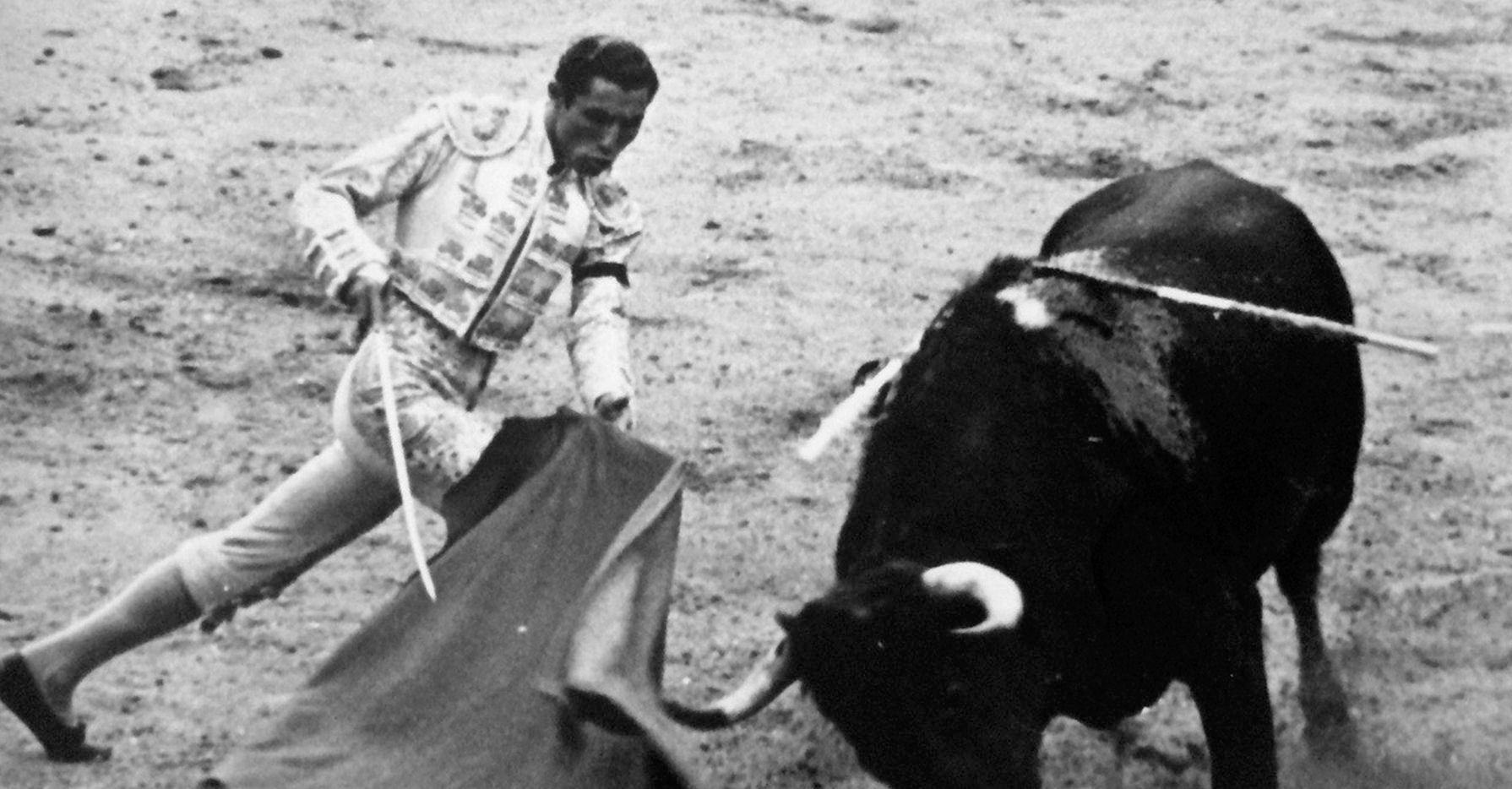
The following is a feature article from the upcoming LARB Quarterly Journal: Spring 2016 edition. Become a member of the Los Angeles Review of Books to receive your copy of the Journal.
¤
All images courtesy of Colin Dayan. All rights reserved.
¤
I TRY TO ARRANGE the photographs. They were developed by my father sometime after he returned from his honeymoon in Mexico. I do not know what to call the man in the embroidered costume; he looks vaguely Spanish. He is a killer, but a killer with a flourish. He spins round the bull and spears it, looking down so gravely at the stricken animal. No, the spear or sword or lance is already in the shoulder, broken in two, over the raised wreck of flesh. So what is he doing? In one photo he holds a cape. It must be red. Isn’t that the story I heard? “Bulls don’t like red,” my father told me. So one flash of a cape, and the bull “goes mad.”
A pile of 24 black-and-white photos lie on my desk. I recognize the same man in 13 of them. I know him by the waves in his hair. Is he a matador? Or is it the picador? The one who stabs and pierces flesh. My father. Sweet Edmond. Kind Edmond. The bull’s legs catch my attention. Holding tight under the shock of a strike, the legs paw the earth, digging up the dust, kicking back in a stretch too graceful for the vile if choreographed assault. The great glory of man, dressed up and ready to harm. The head of the bull turns and dips toward the earth, as one front leg seems to find balance. All I have is the dizzying perception of legs spread and angled, holding on, digging down. The face of the man fades into the black thick pelt of the bull. I search now for expression in the eyes of the animal so assailed by the vain spectacle set to the prance of the killer. All I want is to catch some sense of the bull’s feeling, sufficient in attentiveness — the will caught in photo after photo, until the end when the body falls to earth, stilled in the shadow of the man who struts and looks out at his admirers.
When my father and mother married in 1939, they moved from New York to Nashville, and then left for Mexico. They drove their Buick Super 8 from Guadalajara to Cuernavaca, traveling along roads Graham Greene first captured in The Lawless Roads and then in The Power and the Glory, but I doubt they ever read him. My father didn’t like Catholics. I do not know any details of their journey. No one even told me stories. All that remains of the visit are hundreds of photographs. There was never any need for words.
Over 50 years later, more than half a century, I look at the pictures. Out of boxes and other wooden and steel containers, and buried deep under other albums, come these relics of a honeymoon.
Those days were not remembered. They were not part of anything I knew, nor did they make up any kind of beauty my parents might retrieve about a past when they might have known love or passion. I spent my life not knowing the difference between the two. There was no warmth in my house, no sight of a kiss, except once or twice when my father tried to peck at my mother’s lips as if he was ashamed, a moment in time preserved for me now only in her grimace. Lust I knew. The long afternoon phone calls when my mother rested on her bed behind a door that was not quite shut. Her legs I could not see. They were under the sheet. I remember a hand moving quickly. Yes, between her legs. Yes, as she laughed and sounded different than usual. Or was that love, as one hand languidly moved up and down, and the other held the phone very close to the ear.
But now before me, there now on my desk, I try to get through my father’s cracked leather-bound albums. A gift, a glorious preservation of a past otherwise lost forever. These photographs from the first months of their marriage lie in wait for me. Once I look at them I might know something beautiful that I did not know before.
My mother’s face, caught in poses that were never off-guard or random, does not speak to me. She still has that immaculate quality of being purified of anything living. In one photo, bent down, stooping in the dirt and surrounded by parrots, she seems dead, her smile frozen for the camera. A bracelet on her arm and a tan on her flesh, dressed in white and hair pulled back, she looks down at the birds. But she is not really seeing.
Then there is the pose of glamour. Looking out at my father. Maybe she saw this fashion somewhere in some movie of the ’30s, the hand drawn up on one side, sultry on the hip.
A beauty.
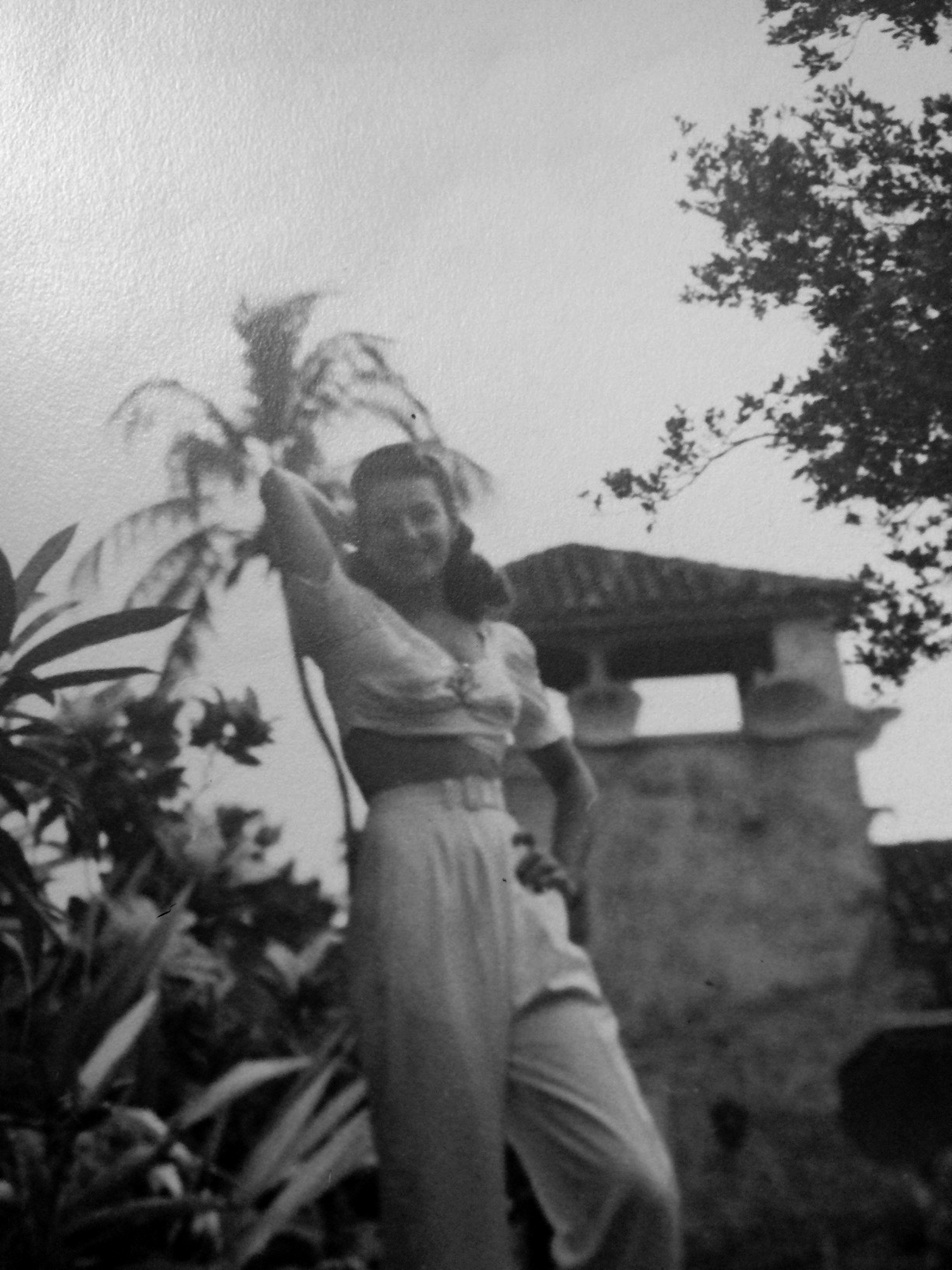
¤
Some of the photographs are laid out 10 to a page, on black hard paper; the pictures one upon the other are taped down. To look through them I must lift each one separately. I can only see one at a time, at any time.
My mother never looked at the photos. She had no interest in revisiting the past. I did.
Once I moved to Nashville, the past began to fill the emptiness of my life. It came forward when I least expected it.
I look at the pictures of her, lifting them up out of boxes as though they were dirty. It felt the same as when I went through my mother’s bedroom dresser drawers, fingering the bras and panties, pulling them up to find pictures of naked bodies, men in poses with a penis in hand, or a tongue on the buttocks.
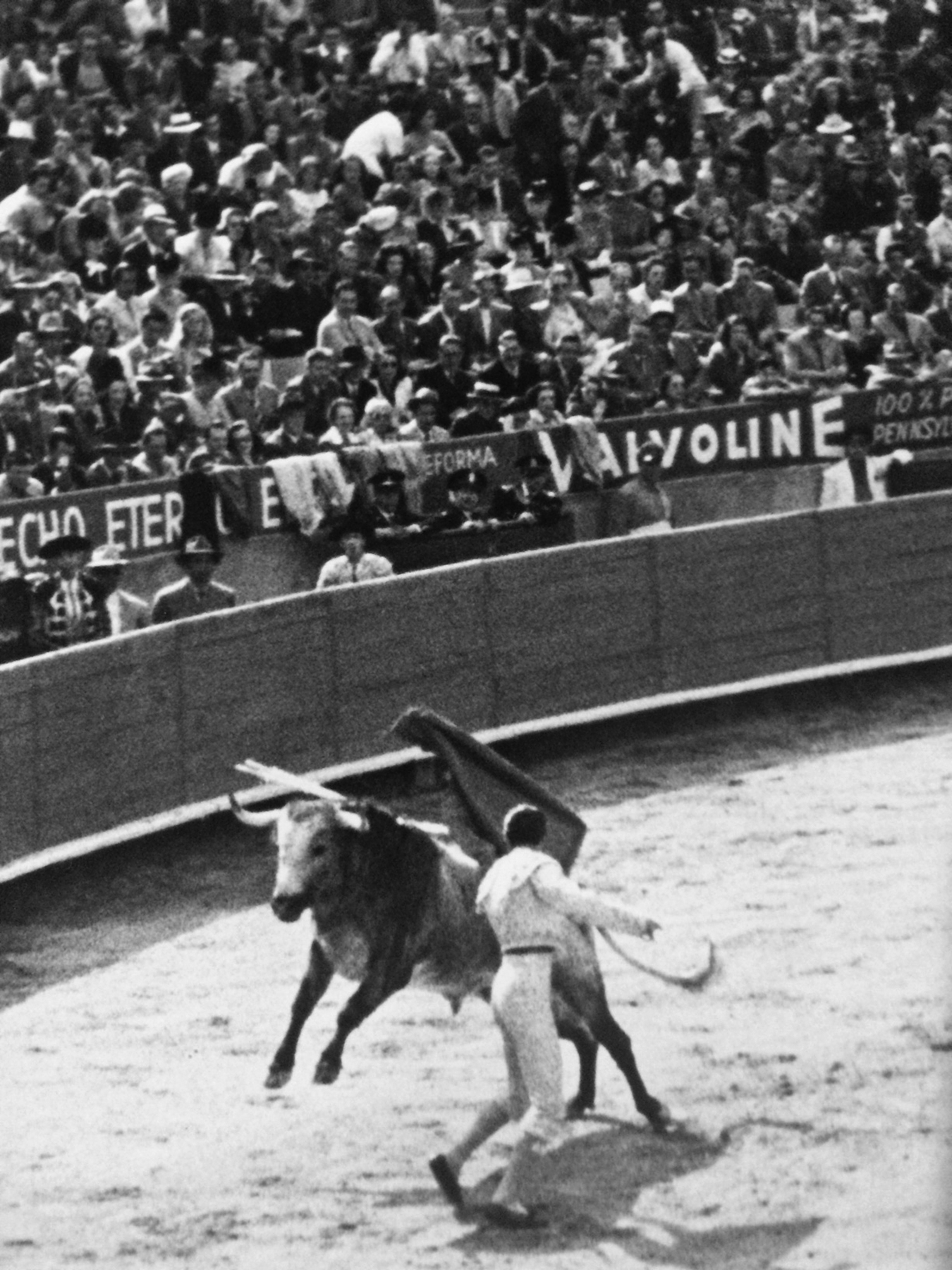
But the bulls are different.
The bullfights are on large 8x10 prints. Taunted, prodded, stabbed, the animals know what it is to be killed by humans. They sense that something distinctly upbeat comes along with their suffering. They hear the glee in the shouts from the stands. What, I wonder, along with the bulls, causes such elation? It seems that the more stricken the animal, the louder come the euphoric shouts. In the photos, the people are white. Whatever their nationality, their skin is white. Some of the men smile. Others look entranced by the bull’s persecution. They all wear suits. And what about the women? I look at their faces. Two women smile next to each other. Are they getting ready to laugh? Another breaks into a wide grin. Some look bored. One smirks. Another turns to her friend. Is she looking away from the dying bull, or sharing a joke? None look amazed or troubled. If I look through these photographs long enough, I begin to lose interest in the audience. Then, I look back at the bull. There.
I find something that pulls me into concern, a regard that will not quit. Not something so broad as torment — the horrific wariness, then involuntary capitulation of the bull as a general body of flesh moving steadily toward ruin — but instead things that touch my heart more strongly than I could have anticipated: the spin of a tail in a semicircle; the slight lifting up of a head, then a mouth shut tight or faintly open, the tongue unseen; a head bowed as the legs become straight, poised while preparing to stand precisely in the site of pain. I try to look at the eyes. The black of the bull is so deep that it is difficult to see something as definite as expression. Most of the photos were taken to get the conventional shape of the conflict, the black mass of bull and the costumed curves of man. But in a few, I can see brightness, an indecipherable touch of light, a bull’s-eye view of the dismal panorama of cape flung out, the tormentor’s feet rising from the ground as the dirt flies up into the eyes I had just begun to rely upon as something not marked by death. I feel now that each picture confirms suffering that is effectively without end.
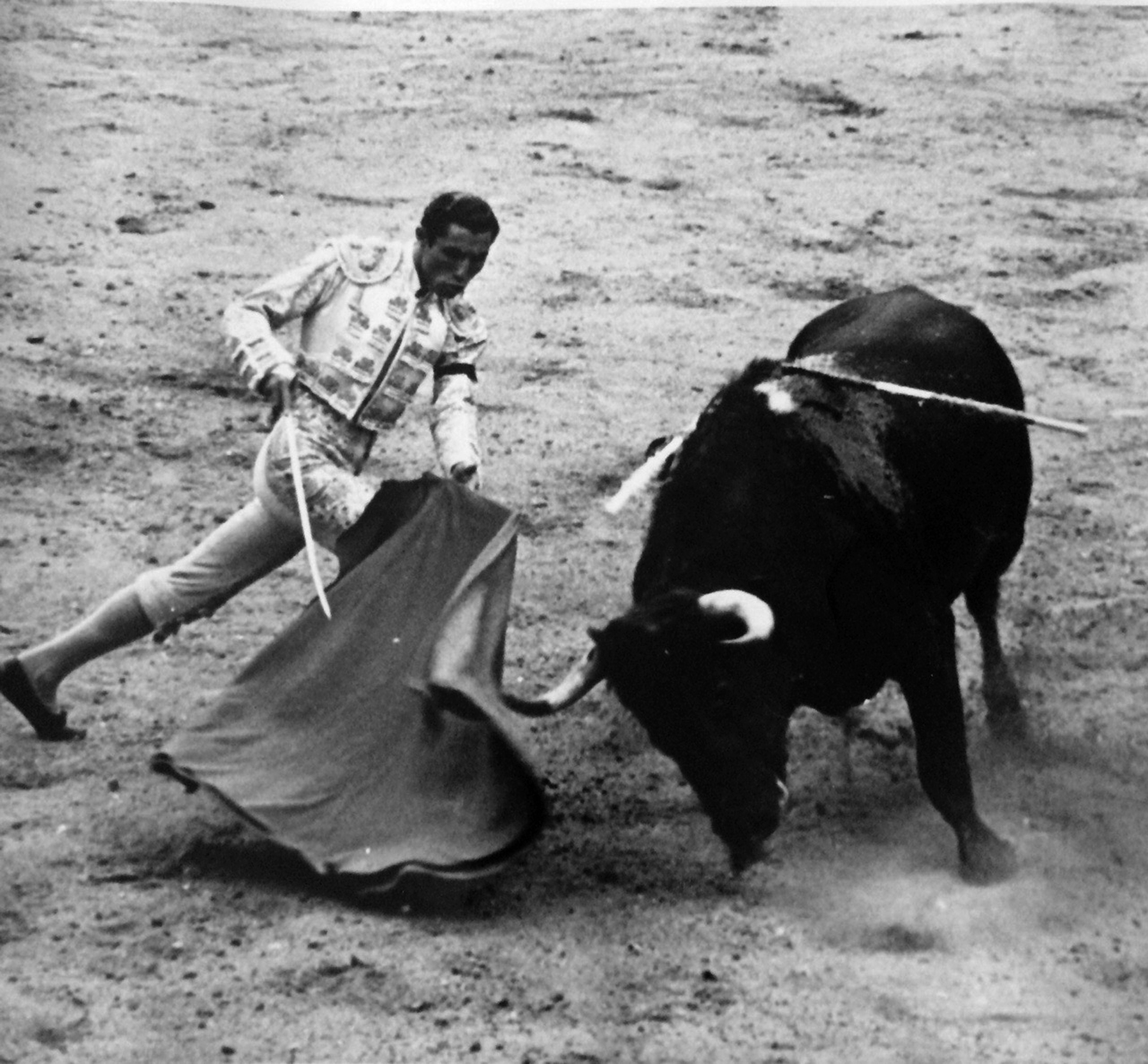
¤
The marriage was doomed. My father went to the bullfights. During those afternoons, what did my mother do? The man rides the horse, a carnival picador dressed as if for a state fair in Georgia, spearing the bull. The bull is real. The bull is too gorgeous to be killed. More beautiful than my mother, or at least alive to the touch in a way she could never be. As I remember my mother and her broken life, I can’t stop thinking about the bulls, the many bulls isolated from their kind, released into spectacle, performing their agony, the light in their eyes slowly turning into dark.
Dust, photographs, pile upon pile. It hurt me to look at them. So I took all the photos, hundreds of them in albums, cases, loose, or whatever — and put them back in the garage. But I kept the bulls dying in effigy on my desk.
This is a story about how bulls die, the blood, the curve of horns, and the lift of a head in response to the matador’s formal low passes. The bull’s head is raised high as the body collapses. But the legs are strong in their denial, the poise still fierce even as the legs stand apart. Some writers suggest a shared physical delight between human and bull. I do not see that reciprocity here. It is an invention by humans, for humans.
In On Bullfighting, A. L. Kennedy describes the “curious, intense dance between two species […] as blood wells out of the bull’s wounds.” But what kind of sharing could be had in such an encounter, and why do writers so often recall it as rare evidence of the reciprocity between species? The progression of the corrida from mutual alertness to the matador’s deliberate stalking and the bull’s growing exhaustion signals a peculiarly human cruelty. Terrible and majestic, yes, but also absurd: self-importance masked by the stiff brio that comes across as play. “It is up to the bullfighter to make the bull play and to enforce the rules,” Hemingway reminds his readers in Death in the Afternoon. Then he adds, in a sleight of hand that gives his writing assurance at the very moment when it falters in glaring abstraction: “The bull has no desire to play, only to kill.” I look at the photo, with the bull’s back torn by the pica. Not a spear, exactly, and not a sword either, but a pick, a narrow wooden shaft with a steel point. Broken, the stick splinters in two.
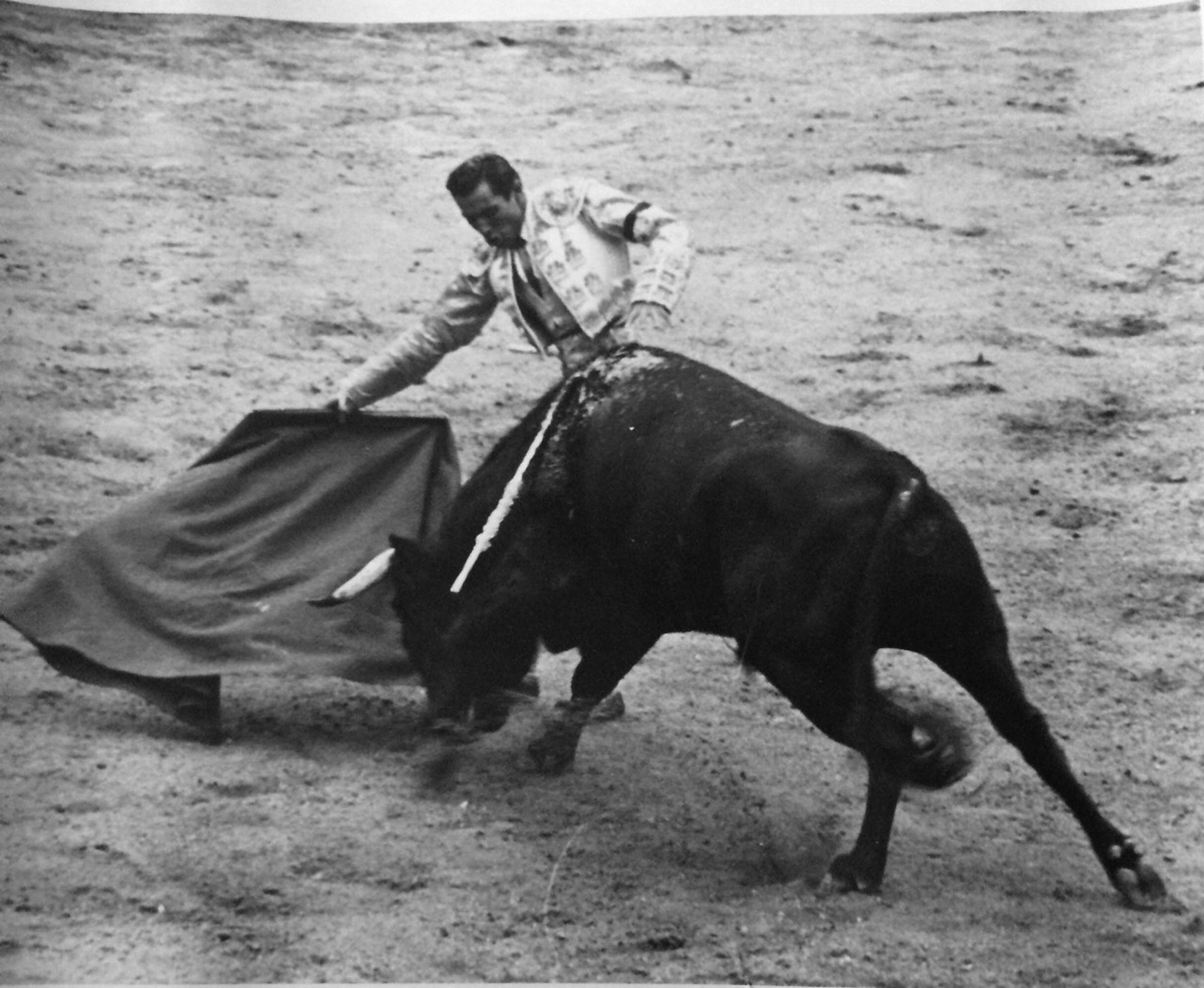
I have no choice now but to look through the series of photographs that portray the matador — at least two different men in more than one fight, one with a ponytail and the other with a short coif, both in embroidered jackets — and the bull in the final passes of the cape, the still small step of the bull, a final surge, a momentary charge that is disrupted by the body that now seems heavy as lead, in places already caving in, soon to collapse, wounded, head lowered in a gentle arc, flanks heaving, tendons and muscles strained, legs bent with the shadow of his scrotum caught in one of the pictures, the end of the tail spinning so fast that the hair-become-feathers catches hold of my attention. Many times I look away. My mind drifts somewhere else, wondering why I no longer care about a honeymoon that left my mother cold, my father clueless. But not for long, since I am drawn again, brought to focus by the bull’s legs. They tell me all I need to know about phenomenal grace and something more than beauty, for how can feet fixed in dirt, then raised up in the air at the strike, muscled with life then holding on in death, a head swerved gently, perhaps nodding in recognition of hurt, be anything but compelling, more absorbing than the flourish of the man with the cape? I place all my hope in the fleshly pads of the underside of the bull’s hooves, in the head hanging weighty and too low, in the tail that never ceases to move soundlessly through the air, in one back leg pushed out straight either to move the bull forward or to keep the body still as the head turns massively into the cape. This cape is doubled over a wooden stick or rod. It is called the muleta. When the muleta appears, everyone knows this marks the third and final stage of the bullfight, when the bull is weary or aplomado: in Hemingway’s words, “he has been made heavy, he is like lead; he has usually lost his wind, and while his strength is still intact, his speed is gone.” Now the sword will be used.
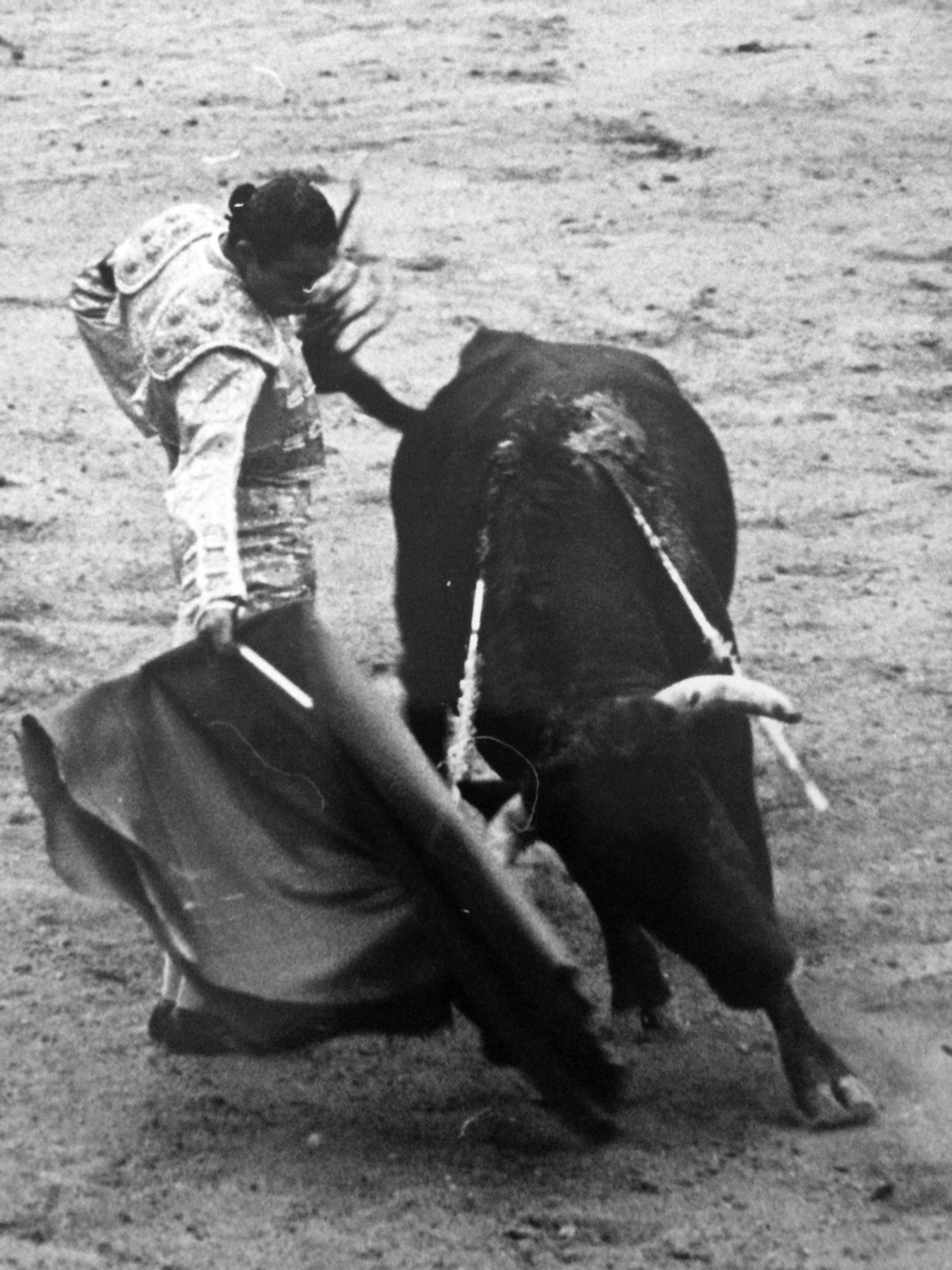
Death by cape and by sword: in one picture, a sword and cape held out in one hand; in the next, the sword in the right hand, the cape in the other.
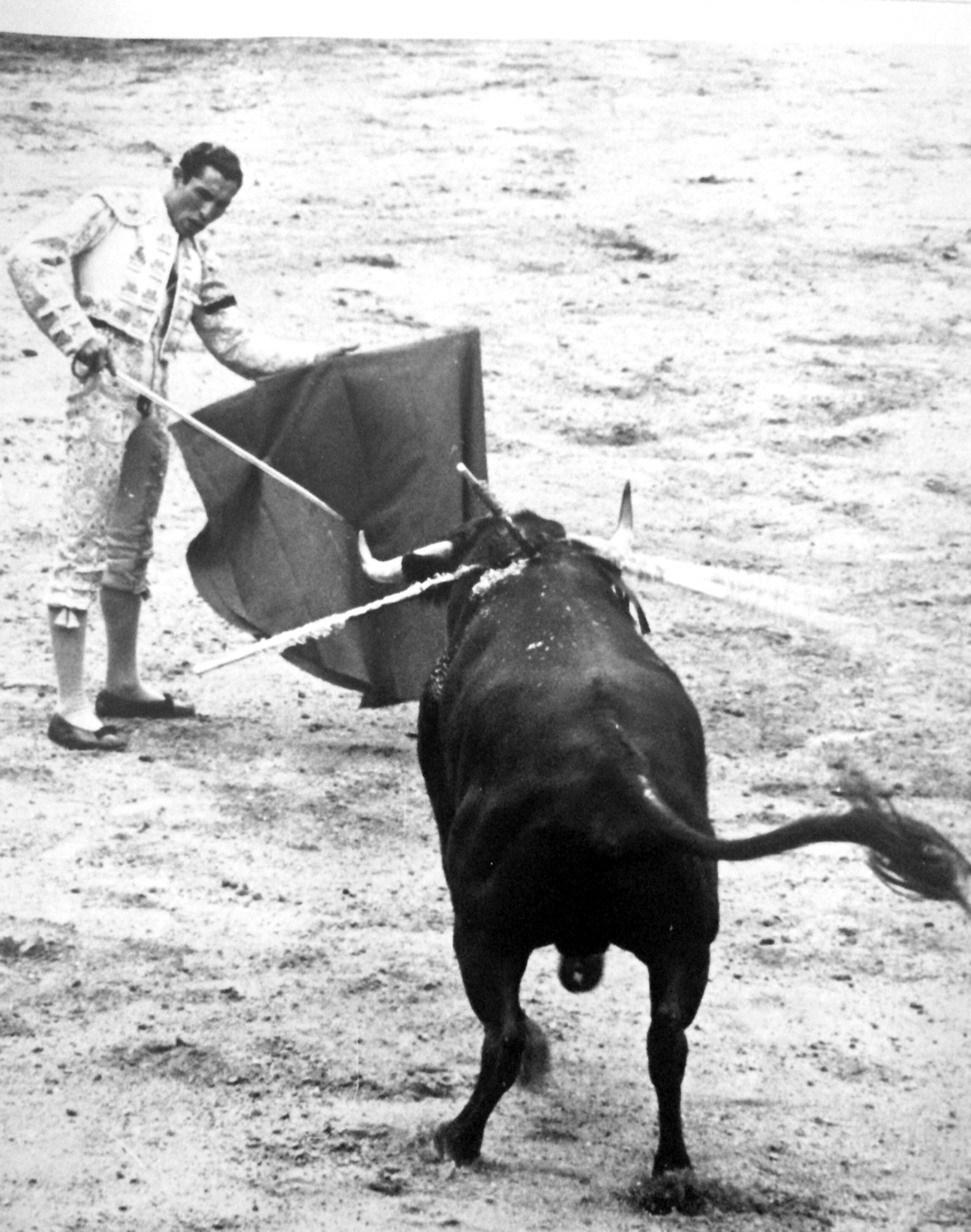
¤
I have tried to put them in order, these photographs that stay on my desk. Thousands of negatives remain in the brown boxes in the garage. Perhaps they contain images my father chose not to develop in his darkroom so late at night when my mother had already turned her back on him.
During the time I spent looking through the pile of photos, arranging them in some order that might make sense of them, a growing unease took hold of me. I stopped writing. Now when I go back to the desk I face pieces of a performance that no longer hold together, that cannot be made whole. I read again descriptions of the bullfight, as it should be or was, the ritual in three parts, with only one correct way of killing the bull, of rousing the crowds that watch it charge and die, of exhibiting the splendor and exact formality of the matador, with all his macabre grace.
Again I take the photographs and spread them out, all of them. Here is the picador in this single photo of a man on horseback, all a-jingle with his short jacket and tight breeches, like any other bullfighter except for the crazy white hat that sits on his head. And then there is the horse. Is he blindfolded? Horses die, and no one seems to mind. Even Hemingway admits the horror of such a death, entrails falling away from the wound — though he can’t resist identifying disemboweling as one of those “strange and burlesque visceral accidents” so integral to the experience of the bullfight. There are no banderilleros or flagmen in sight, not in any of these photos. I see quite clearly the bull pelt made jagged, the flash of metal against the dazzling sun. Into that part of the neck atop the shoulders where muscles ripple comes the goad: as the bull tosses his head, these men plant barbed sticks that pierce the skin. Splendidly colored flags, paper strips, even ribbons are attached to these stick-blades, making a mockery of torment. Under this flutter of color and after many tiny stabs, the hump — the place between the neck and the top of the shoulder — is weakened, the muscles relaxed, the head lowered so that the sword can go in for the kill.
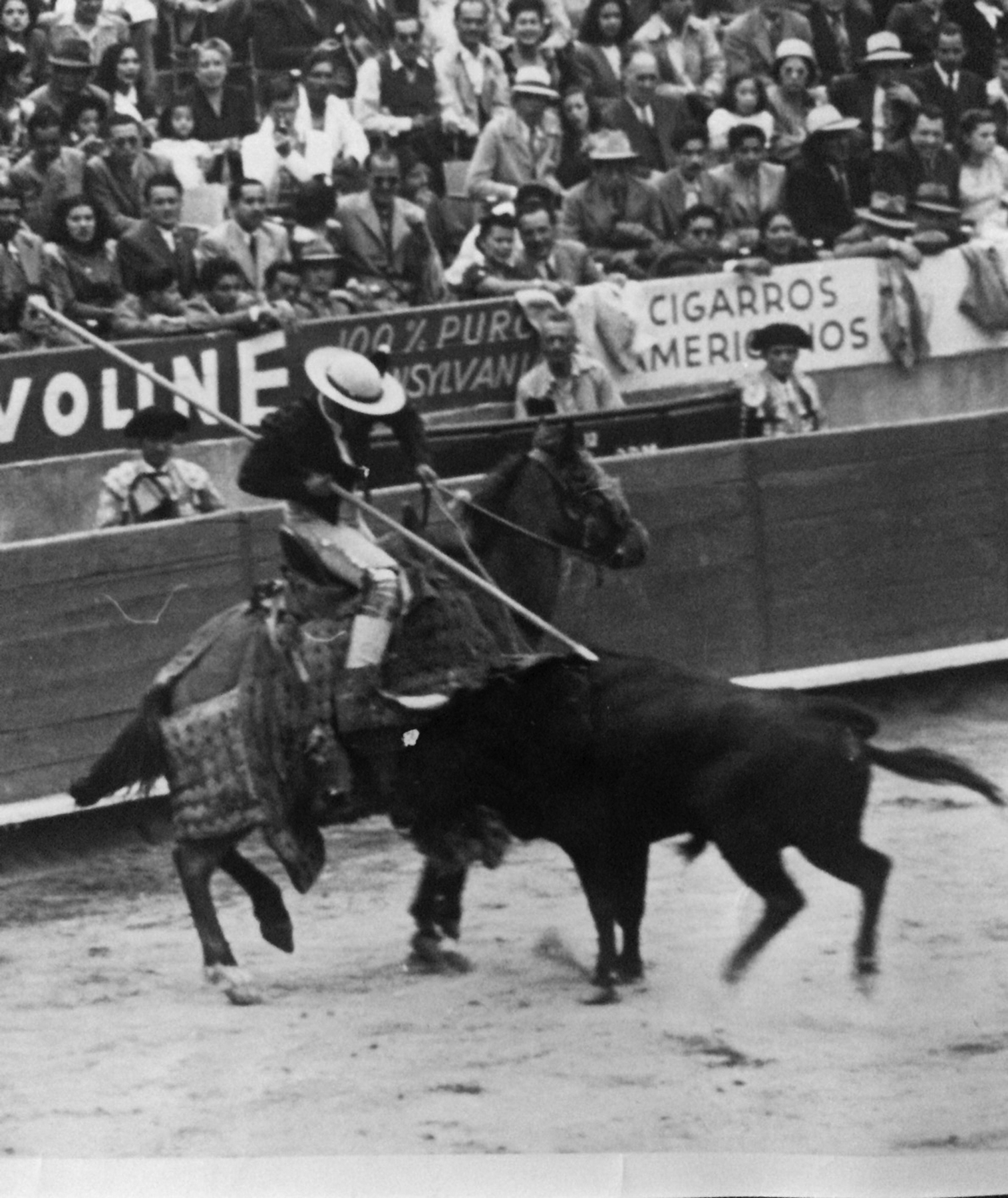
Now the bull collapses. Wearily, he sinks to the ground, resting it seems on one horn. The sound the sound the sound, I repeat to myself; what is the noise heard when the bull knows he is being murdered, when, deadly tired and pierced to the bone with picks, darts, and the ultimate lance thrust, he cries out in the arena to the cheers of a crowd? Who has written about the noise a bull makes? No one cares about the death rattles and groans, the bellowing that shakes up the performance with a strength that will not suffer humiliation.
The bull is dead in the sand, so huge and lost that he reminds me of a harpooned whale that has been washed to shore.
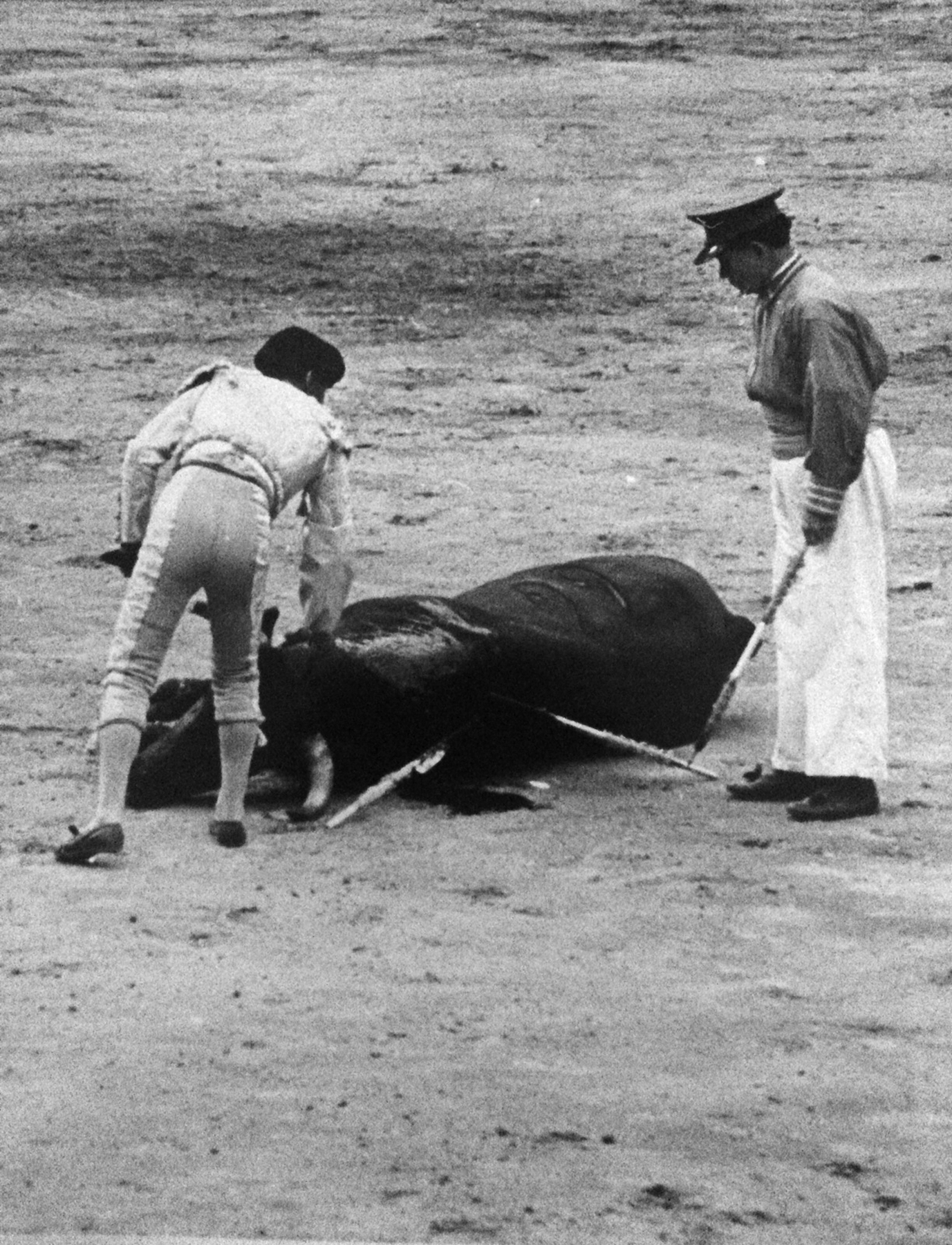
¤
“Toro, toro,” I hear the words in my mind. That nearly imperceptible memory comes to me now. I recall how we used to play bullfighter in my backyard. The game consisted of someone flashing a red scarf, or maybe a sheet of any color, in my face as I ran toward it. That was all: the lift of a cloth and my mad dash through it and beyond into some place where I lay along the dark earth in dead silence.
There I remained, hidden, my mouth open. I did not want to be the bull anymore.
¤
LARB Contributor
Colin Dayan is Robert Penn Warren Professor in the Humanities and Professor of Law at Vanderbilt University. Her recent books include The Law Is a White Dog: How Legal Rituals Make and Unmake Persons, The Story of Cruel and Unusual, and, most recently, With Dogs at the Edge of Life. She is a member of the American Academy of Arts and Sciences.
Did you know LARB is a reader-supported nonprofit?
LARB publishes daily without a paywall as part of our mission to make rigorous, incisive, and engaging writing on every aspect of literature, culture, and the arts freely accessible to the public. Help us continue this work with your tax-deductible donation today!